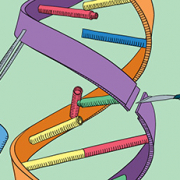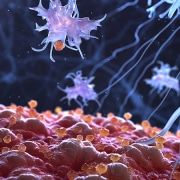Diagnosing mitochondrial conditions: a WGS breakthrough
Mitochondrial conditions can be difficult to diagnose – but why, and how can genomic technology help?
New research into the genetic cause of mitochondrial conditions has shown that whole genome sequencing could help speed up the diagnosis of these conditions for patients. The findings also suggest that other genetic conditions not related to mitochondria could be diagnosed through this approach.
Mitochondrial disease
Mitochondria are organelles – small structures found in nearly all the cells in the body. They process the chemical reactions that fuel everything the cell does that requires energy. Cell types that use more energy, such as muscles and brain cells, tend to have more mitochondria.
The range of symptoms that can be present in people with mitochondrial conditions is varied, although tissues with high energy demands such as the brain, nerves, heart, muscles and eyes are most commonly affected. Because patients may have symptoms in several systems, mitochondrial disorders can be difficult to diagnose and differentiate from other conditions.
Although individually rare, together mitochondrial diseases make up a significant proportion of inherited metabolic diseases, affecting around one in 5,000 people.
Genomic complexity
More complexity arises from one feature of the mitochondria themselves: a ring of DNA containing 37 genes, entirely separate from the genome in nucleus.
The mitochondrial DNA (mtDNA) is essential for healthy mitochondrial function, but so are around 100 genes found in the nucleus that encode many proteins essential for building mitochondria.
As such, mitochondrial disease can be caused by harmful variants in either the mtDNA or the DNA in the nucleus, and can therefore follow many different inheritance patterns, depending on the gene affected. For example, autosomal dominant, autosomal recessive or X-linked for genes in chromosomal DNA, as well as de novo variants.
Because of this variety, as well as the fact that patients can present at different ages, many affected families face a challenging ‘diagnostic odyssey’, often seeing multiple specialists before getting a diagnosis.
Whole genome sequencing
New research from the Medical Research Council Mitochondrial Biology Unit and the University of Cambridge suggests that whole genome sequencing can speed up diagnosis of mitochondrial conditions and can provide a diagnosis in 31% more cases compared to standard testing.
The study, published in the British Medical Journal, looked at whole genomes from 319 families with suspected mitochondrial disease, recruited from the 100,000 Genomes Project.
They were able to provide 98 families (31% of participants) a diagnosis that was not picked up by standard tests. More than half of these families had rare genetic conditions that were not related to mitochondrial function but had similar symptoms.
“These patients were referred because of a suspected mitochondrial disease and the conventional diagnostic tests are specifically for mitochondrial diseases. Unless you consider these other possibilities, you won’t diagnose them. Whole genome sequencing isn’t restricted by that bias,” said study author Professor Patrick Chinnery.
“We recommend that whole genome sequencing should be offered early and before invasive tests such as a muscle biopsy,” he added.
The results also showed that mitochondrial conditions might be more genetically diverse than was previously thought. Many patients with a mitochondrial disease diagnosis had variants in genes known to affect mitochondrial function, but the exact variants were unique to their family.
Follow this blog for more news about the application of whole genome sequencing in the diagnosis and treatment of rare disease.
–









